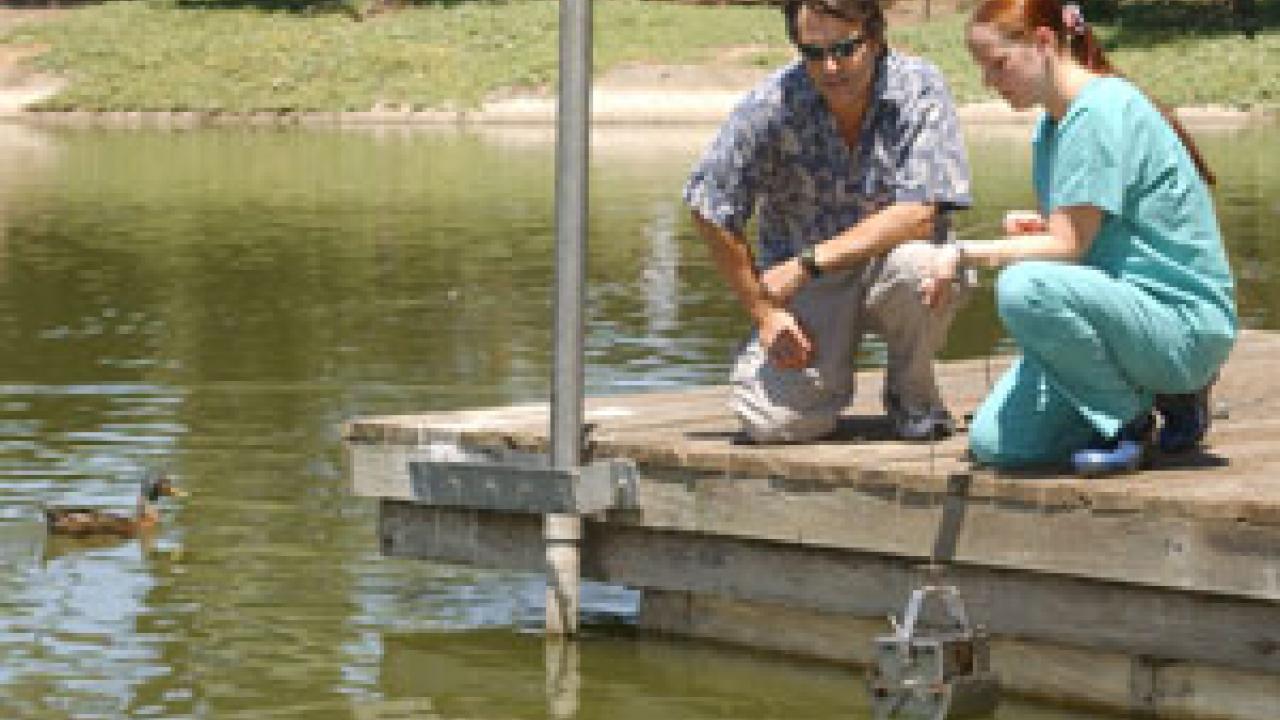In a perfect world, how many ducks can the arboretum handle?
The answer -- three ducks, almost. That's right, shaving a few feathers, 2.92 ducks to be exact. At least that's what the student science project recommends.
It's a surprising number, admits John Eadie, a professor of wildlife biology. His winter quarter class, Wildlife, Fish and Conservation 136, undertook a study of how many ducks the arboretum can manage based on the amount of space and food.
"The goal was to contrast the arboretum on campus with natural wetlands and determine how many waterfowl can be supported based on habitat acreage and foraging needs," said Eadie.
The class was an exercise in conservation planning, he said, to examine how much habitat is needed to support a desired population of wildlife.
As anyone who has strolled the banks of the campus's ecological jewel knows, there's a lot more than three ducks swimming and lurking around.
Based on surveys, Eadie's undergraduates estimated that from 206 to 323 ducks call the arboretum home. Species range from wild mallards, Call Ducks, Blue Swedish and Indian Runners. About 73 percent of the ducks are males.
The arboretum occupies about 100 acres along the old north channel of Putah Creek. Compared to the vast wetlands that host most migratory waterfowl in the Central Valley, the arboretum is a small sliver of land without the vigorous water flow and natural foraging opportunities of those wild habitats.
The human-to-duck feeding so commonplace in the arboretum serves to artificially increase the duck numbers, Eadie said. He points out that ducks naturally feed on seeds and invertebrates -- not Wonderbread.
As student Jody Deal said, "this is a problem because this is not a natural diet for them and the ducks come to depend on the handouts to survive."
Said Eadie, "I'm certainly not saying we should get rid of the ducks; we all love them. Rather, it's a question of balance. One can argue that having all the ducks gives some people a personal connection through feeding them while motivating others to dedicate themselves to wildlife and conservation efforts. The class was exposed to the difficult choices we must consider in modern wildlife conservation."
Ellen Zagory, director of horticulture at the arboretum, is well aware of the ducks' popularity. "I give tours all the time, and people just go crazy over the ducks," she said.
In the upcoming year, Zagory said, the arboretum will collaborate with researchers in the Department of Wildlife, Fish and Conservation Biology in conducting population surveys of all the wildlife in the arboretum -- ducks, ground squirrels, herons, egrets, fish and ants, for example.
Zagory said, "Once we collect and analyze this information we will be able to make management decisions based on good science, which will help us protect all species in the arboretum including plants and aquatic animals."
Eadie's 14 students used a "bioenergetic model" that focused on the amount and type of habitat needed to maintain projected populations. This formula measured the number of acres needed for each bird, the number of birds, the energy or "food" needed for each bird, and the food available on each acre. This is where the 2.92 figure comes from.
In order to estimate the number of ducks that can be supported on "natural" food sources -- assuming that the arboretum was functioning much like a semi-natural wetland in the central valley -- the class calculated the number of ducks that can be sustained energetically.
"With these samples, we then can calculate the energy provided by these food items -- using published conversion factors per unit weight -- and can then scale this for the whole arboretum," said Eadie.
He noted there are, of course, a number of assumptions, for instance that the ducks have no other food source and that the food sample is non-renewable.
Eadie said that based on these assumptions and determining the energy required per day for a mallard duck, the class found that the arboretum habitat was suitable for 2.92 ducks per year (or 1,065 duck use days).
What if the modeling is changed?
"We can relax our second assumption and assume that the amount of food is replenished every day, except seeds, which are produced only once per year," Eadie said. "When we do this, we get a sustainable population of 23.39 ducks per year, or 8,536 duck-use days. So, the sustainable population is somewhere between three to 24 ducks with 24 being a very liberal estimate."
For fun, Eadie calculated the number of loaves of bread required to meet the demand of the existing duck population. He came up with more than 14,000 loaves a year or 38 loaves per day.
The students reported several problems with the effect of duck overpopulation in the arboretum, including their effect on plant and water collections, large nutrient deposits in the water, and domestic ducks interbreeding with wild ducks.
As Deal put it, one of the problems of overpopulation is a disease outbreak like botulism, which could kill both the hybrid and native ducks.
To better limit the duck population and protect the arboretum, the class suggested that the campus could:
- discourage human feeding by posting more signs and possibly fining violators;
- fence sensitive plant and aquatic areas;
- train ducks to avoid plants and bread via taste aversion; and
- improve the production of natural aquatic plants.
Media Resources
Clifton B. Parker, Dateline, (530) 752-1932, cparker@ucdavis.edu
